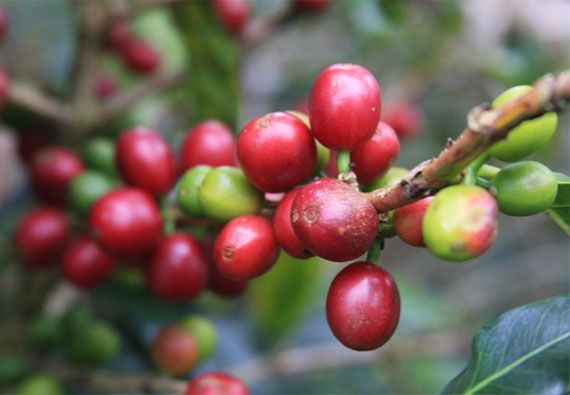
Like a fine vintage wine, 100% Kona is distinguished from lesser coffees by the tremendous extra care taken through every step of its production.
It is grown only in Kona, on the west coast of Hawaii Island (also known as The Big Island), where coffee has been produced continuously since the early 1800s. On the slopes of two volcanoes, Hualalai and Mauna Loa, the coffee growing district is about 22 miles long and two miles wide, at an elevation between 500 and 2800 feet approximately. Coffee that is grown elsewhere in Hawaii cannot be called Kona coffee.
 Naturally high quality, most Kona coffee is graded "Prime" or better because of the climate, the careful hand-cultivation, and the wet-method processing used throughout the region. This excellent quality has made Kona coffee one of the two most highly valued coffees in the world.
Naturally high quality, most Kona coffee is graded "Prime" or better because of the climate, the careful hand-cultivation, and the wet-method processing used throughout the region. This excellent quality has made Kona coffee one of the two most highly valued coffees in the world.
Kona's sunny mornings and cloudy afternoons is the exact climate the coffea arabica plant prefers. The trees thrive on the volcanic rocky land, and mild frost-free temperatures. An integral part of the Kona region's beauty are the lush green slopes covered in old growth coffee, especially in spring when the air is perfumed by the fragrant white coffee blossom (snow).
The Kona region contains around 600 independent coffee farms. Most are small, usually three to seven acres in size. Traditionally, as with most farms, they are a family concern. In 1997 the total Kona coffee acreage was 2290 acres and green coffee production just over two million pounds.
Cultivation, Production, and Processes
100% Kona coffee is distinguished from commercial blends by the tremendous extra care taken throughout every step of the process. The end result is a coffee that carries the unique stamp of the Kona region — delicate yet flavorful and with a rich aroma — a product that is famous among coffee drinking societies throughout the world.
 Coffee cultivation is more labor intensive in Kona than in most other regions. From late August to late January, the Kona coffee farmer is singularly focused on bringing in the ripe red coffee cherry, processing the cherry into coffee beans, and preparing for the sale or storage of their coffee. Hand-picking is a meticulous process than insures that only cherries at peak maturity are harvested.
Coffee cultivation is more labor intensive in Kona than in most other regions. From late August to late January, the Kona coffee farmer is singularly focused on bringing in the ripe red coffee cherry, processing the cherry into coffee beans, and preparing for the sale or storage of their coffee. Hand-picking is a meticulous process than insures that only cherries at peak maturity are harvested.
Most Kona coffee farmers sell at the fresh coffee cherry level but there is a recent trend to take a farm?fs coffee further along the process, selling at the parchment level, the green, and the roasted levels. There are more than 100 private labels for 100% Kona coffee in the State of Hawaii.
The coffee cherry is pulped to remove the outer flesh, carefully fermented, which helps give the coffee its characteristic bright, clear flavor, and thoroughly washed in clean water. Most coffee is then naturally sun-dried on large decks (hoshidanas), and raked regularly to give even drying.
The dry beans are machine milled to remove the parchment and silverskin, and the resulting green beans sorted and graded. The green beans may be sold to roasters, or roasted by the farmer or processor to produce a unique coffee. The rest of the Kona coffee farmer's year is spent in cultivation of this world renowned gourmet coffee. Farmers prune non-productive growth, select future growth, fertilize three times annually, and maintain the farm.









